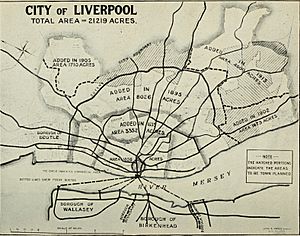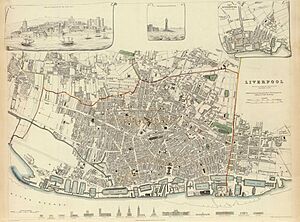Timeline of Liverpool facts for kids
Liverpool is a famous city in England with a long and interesting history. It started as a small settlement and grew into a huge port, playing a big role in trade and culture. This timeline will take you through some of the most important moments in Liverpool's past, from its early days to becoming a modern city known for its music, football, and friendly people.
Contents |
Early History of Liverpool
- 1089: The area around Liverpool, called the West Derby Hundred, is first mentioned in the Domesday Book, a famous survey of England.
- 1207: King John officially grants Liverpool a charter, allowing it to have a market and grow as a town. This is often seen as the start of Liverpool.
- 1237: Liverpool Castle is built. It stood for many years before being taken down.
- 1295: Liverpool sends two representatives to the first royal parliament, showing its growing importance.
- 1349: The terrible Black Death plague reaches Liverpool, affecting its population.
- 1598: Speke Hall, a beautiful old house, is built.
- 1644: During the English Civil War, the town is attacked by Prince Rupert of the Rhine's forces.
- 1662: The population of Liverpool is recorded as 775 people.
- 1674: The Town Hall is rebuilt, showing the town's development.
Liverpool in the 1700s
- 1700:
- The Liverpool Merchant slave ship starts its operations.
- The population grows to 5,714 people.
- 1708: The Blue Coat School is founded, providing education for children.
- 1715: The first official dock, called the Old Dock, opens. This is a huge step for Liverpool's port.
- 1720: The population continues to rise, reaching 10,446.
- 1726: Liverpool Castle is taken down.
- 1749: The Royal Infirmary, a hospital, opens.
- 1754: The grand Liverpool Town Hall is built.
- 1756: The Liverpool Advertiser newspaper begins publication.
- 1771: George's Dock opens, adding more space for ships.
- 1778-1779: Liverpool becomes a hub for privateer ships, which were privately owned ships allowed to attack enemy vessels during wartime.
- 1785: The Liverpool Georgian Quarter, known for its beautiful old buildings, is constructed.
- 1791: The School for the Blind is founded, showing a focus on helping people.
- 1797: The Liverpool Athenaeum, a club for learning and literature, is founded.
Liverpool in the 1800s
Early 1800s: Growth and Change
- 1801: Liverpool's population booms to 77,653.
- 1803: Botanical Gardens open, offering a place for nature and science.
- 1807:
- Many Liverpool ships were involved in the slave trade.
- The Slave Trade Act in the UK and the Act Prohibiting Importation of Slaves in the US outlaw the Atlantic slave trade. This was a major change for Liverpool.
- 1810: The Williamson Tunnels are started. These are a mysterious network of tunnels under the city.
- 1816: The Leeds and Liverpool Canal is completed, connecting Liverpool to other parts of England by water.
- 1819: The SS Savannah completes the first steamship journey across the Atlantic Ocean.
- 1822: The old St John's Market is built.
- 1826: The Old Dock is closed.
- 1830: The Opening of the Liverpool and Manchester Railway takes place. This is a huge event, as it's one of the world's first inter-city passenger railways.
- The Wapping Tunnel also opens.
- 1831: The population reaches 165,175.
- 1835: The city boundaries expand, and the first elected Town Council takes over.
- 1836: Liverpool Lime Street railway station opens, becoming a major transport hub.
- 1840: The Liverpool Philharmonic Society is founded, bringing music to the city.
- 1846: The Albert Dock opens. It becomes a very important part of the port.
- 1848: Everton football club is founded, starting Liverpool's strong football tradition.
- 1849: The Philharmonic Hall opens, a beautiful venue for music.
Late 1800s: Victorian Era and City Status
- 1851: The Derby Museum opens, offering a place for learning and discovery.
- 1852: A large part of Liverpool's population is Irish, a result of people moving from Ireland during the Great Irish Famine.
- 1854: St George's Hall, a magnificent building, is completed.
- 1855: The Liverpool Daily Post newspaper begins publication.
- 1857: The Mersey Docks & Harbour Board is set up to manage the busy docks.
- 1860: The William Brown Library and Museum building opens.
- 1864: Oriel Chambers, an important early modern building, is constructed.
- 1869: The first council housing in Europe is built in Liverpool, providing homes for many families.
- 1872: Sefton Park, a large and beautiful park, opens to the public.
- 1874: Liverpool Central railway station opens.
- 1877: The Walker Art Gallery opens, displaying many famous artworks.
- 1879: The Liverpool Echo newspaper begins publication.
- 1880: Liverpool officially becomes a city, a big moment in its history.
- 1881: University College Liverpool is founded, which later becomes the University of Liverpool.
- 1884: Anfield stadium opens. It will become the home of Liverpool Football Club.
- 1886: The Mersey Railway Tunnel opens, connecting Liverpool to Birkenhead under the River Mersey.
- 1892: Goodison Park stadium is opened, becoming the home of Everton Football Club.
- 1893: The Liverpool Overhead Railway begins operating. It was an amazing elevated railway along the docks.
- 1895: City boundaries expand again.
- 1898: The Liverpool School of Tropical Medicine is founded, a world-leading center for health research.
- 1899: Liverpool University Press is founded.
Liverpool in the 1900s
Early 1900s: New Century, New Buildings
- 1901: Population: 684,958.
- 1904: The foundation stone of the Anglican Cathedral is laid by King Edward VII. This massive cathedral would take many years to build.
- 1907: The impressive Dock Office is built.
- 1908: Population: 753,203.
- 1909: The world's first Department of Civic Design is set up at the University of Liverpool, leading to the modern idea of town planning.
- 1911: The Royal Liver Building is constructed, becoming one of Liverpool's most famous landmarks with its Liver Birds on top.
- 1914: The reconstructed Adelphi Hotel opens.
- 1916: "Liverpool's blackest day" occurs during World War I, when many men from Liverpool are killed in the Battle of the Somme.
- 1917: The Cunard Building is constructed.
- 1919: Cunard's luxury liner services move to Southampton.
- 1924–1932: India Buildings is built.
- 1925: The Empire Theatre opens.
- 1930: Speke Airport begins operating.
- 1931: Liverpool's population reaches its peak at 855,688.
- 1934: The Queensway Tunnel (Mersey Tunnel) and the A580 road (Liverpool–East Lancashire Road), the UK's first intercity highway, are officially opened.
Mid-Late 1900s: War, The Beatles, and Modern Changes
- 1940–1942: The Liverpool Blitz occurs, with the city suffering heavy aerial bombing by German forces during World War II.
- 1952: Liverpool becomes twinned with Cologne, Germany.
- 1956: The Liverpool Overhead Railway closes, despite protests.
- 1957:
- The famous The Cavern Club opens as a jazz club.
- John Lennon and Paul McCartney of The Beatles first meet at a garden fete. This meeting would change music history forever.
- 1961: The Beatles perform at The Cavern Club for the first time under that name.
- 1962: Brian Epstein signs a contract to manage The Beatles.
- 1963: The Beatles perform at The Cavern Club for the final time as they become global superstars.
- 1967: The Liverpool Metropolitan Cathedral (Roman Catholic) is completed and consecrated.
- 1969: St. John's Shopping Centre opens.
- 1971: The Kingsway Tunnel (second Mersey Tunnel) opens.
- 1972: The Albert Dock closes as a working dock. Seaforth Dock opens nearby.
- 1974: Liverpool becomes a metropolitan borough within the new Merseyside county.
- 1978: The Anglican Liverpool Cathedral is finally completed after 74 years of construction.
- 1980: The Merseyside Maritime Museum opens in the Albert Dock complex.
- 1981: The Toxteth riots occur.
- 1984: The Albert Dock reopens as a leisure attraction, bringing new life to the area. The International Garden Festival is also held.
- 1988: Tate Liverpool, a modern art museum, opens in the Albert Dock.
- 1989: The Hillsborough disaster tragically kills 96 Liverpool F.C. supporters at a stadium in Sheffield.
- 1991: Population: 452,450.
- 1992: Cream (nightclub), a famous nightclub, begins.
- 1993: The Museum of Liverpool Life opens.
- 1998: The Liverpool School of Tropical Medicine is founded.
- 1999: The Liverpool Biennial, a major art festival, begins.
Liverpool in the 21st Century
- 2001: The Liverpool Wall of Fame is unveiled.
- 2004: Liverpool Maritime Mercantile City is registered as a World Heritage Site by UNESCO, recognizing its historical importance.
- 2007: The International Slavery Museum opens, telling the story of the transatlantic slave trade and its impact.
- 2008: Liverpool is named a European Capital of Culture. This brings many events and visitors to the city.
- The Echo Arena Liverpool, BT Convention Centre, and Liverpool One shopping complex open.
- 2011: The Museum of Liverpool opens on the waterfront, showcasing the city's history.
- 2012: The directly elected office of Mayor of Liverpool is established, and Joe Anderson becomes the first mayor.
- 2013: The Merseytram proposal is cancelled.
- 2014: Liverpool TV is launched.
- 2016: Liverpool2 container shipping port opens at Seaforth, a major boost for trade.
- 2017: Steve Rotheram becomes the first Metro Mayor of the Liverpool City Region.
- 2019: The Churchill Way flyovers demolition begins. Anna Rothery becomes the first black Lord Mayor of Liverpool.
- 2020:
- Liverpool goes into a nationwide lockdown due to the COVID-19 pandemic.
- Liverpool F.C. win the 2019–20 Premier League, their first victory of the Premier League era.
- First UK covid mass testing is piloted in Liverpool.
- 2021:
- Joanne Anderson is elected city Mayor of Liverpool, the first directly elected black woman mayor of a major British city.
- Liverpool Maritime Mercantile City is delisted as a World Heritage Site by UNESCO.
- 2022: Liverpool is selected to host Eurovision 2023.
- 2023:
- King Charles III visits the city.
- The office of Mayor of Liverpool is abolished.
- Liverpool successfully hosts the Eurovision Song Contest 2023.
- 2024: Taylor Swift performs a sold-out 3-night residency at Anfield Stadium as part of her The Eras Tour.
|

All content from Kiddle encyclopedia articles (including the article images and facts) can be freely used under Attribution-ShareAlike license, unless stated otherwise. Cite this article:
Timeline of Liverpool Facts for Kids. Kiddle Encyclopedia.


